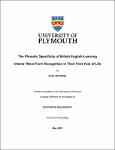The Phonetic Specificity of British English-Learning Infants’ Word Form Recognition in Their First Year of Life
| dc.contributor.supervisor | Caroline, Floccia | |
| dc.contributor.author | Ratnage, Paul | |
| dc.contributor.other | School of Psychology | en_US |
| dc.date.accessioned | 2023-12-14T16:21:00Z | |
| dc.date.available | 2023-12-14T16:21:00Z | |
| dc.date.issued | 2023 | |
| dc.identifier | 10287320 | en_US |
| dc.identifier.uri | https://pearl.plymouth.ac.uk/handle/10026.1/21794 | |
| dc.description.abstract |
Consonants and vowels have been proposed to have distinct functions in speech perception: a consonant bias for lexical processing and a vowel bias for syntactic/prosodic processing (Nespor et al., 2003). Research in adults has consistently demonstrated that consonants have a privileged role in various lexical-level experiments across most languages. However, cross-linguistic differences have been found in the developmental trajectory of the consonant bias. For example, whilst French-learning infants display a consonant advantage in lexical processing tasks by their first birthday (e.g., Poltrock & Nazzi, 2015), British English-learning infants show an equal sensitivity to consonants and vowels until the age of 30 months (e.g., Floccia et al., 2014). Although the lexical and/or the acoustic-phonetic properties of an infant’s native language have been hypothesised to explain such variations, additional cross-linguistic tests of the consonant bias and its potential links to these factors are required. The present thesis explored this by using two experimental paradigms to further examine the phonetic specificity of British English-learning infants’ word form recognition at the onset of lexical acquisition. Experiments 1 to 3 established an equal preference for consonant and vowel mispronunciations of familiar word forms, presented either in isolation or in list form, in 5-, 11-, and 12-month-old infants using the head-turn preference procedure. Experiments 4 and 5 used an eye-tracking methodology to measure whether the congruent presentation of audio and visual speech signals led to a consonant bias in 12-month-olds’ word form recognition. An audiovisual benefit was found, with infants discriminating between phonetic mispronunciations, but only when they viewed a speaker articulate alterations of a single familiar word form. Additionally, neither acoustic factors (Experiment 1) nor lexical factors (Experiments 2 to 5) were found to influence infants’ preferences. Together, the results of this thesis provide further evidence that initial lexical processes vary cross linguistically. | en_US |
| dc.language.iso | en | |
| dc.publisher | University of Plymouth | |
| dc.subject | Word recognition, infants, language development, consonant bias | en_US |
| dc.subject.classification | PhD | en_US |
| dc.title | The Phonetic Specificity of British English-Learning Infants’ Word Form Recognition in Their First Year of Life | en_US |
| dc.type | Thesis | |
| plymouth.version | publishable | en_US |
| dc.identifier.doi | http://dx.doi.org/10.24382/5121 | |
| dc.identifier.doi | http://dx.doi.org/10.24382/5121 | |
| dc.rights.embargoperiod | No embargo | en_US |
| dc.type.qualification | Doctorate | en_US |
| rioxxterms.version | NA |
Files in this item
This item appears in the following Collection(s)
-
01 Research Theses Main Collection
Research Theses Main


